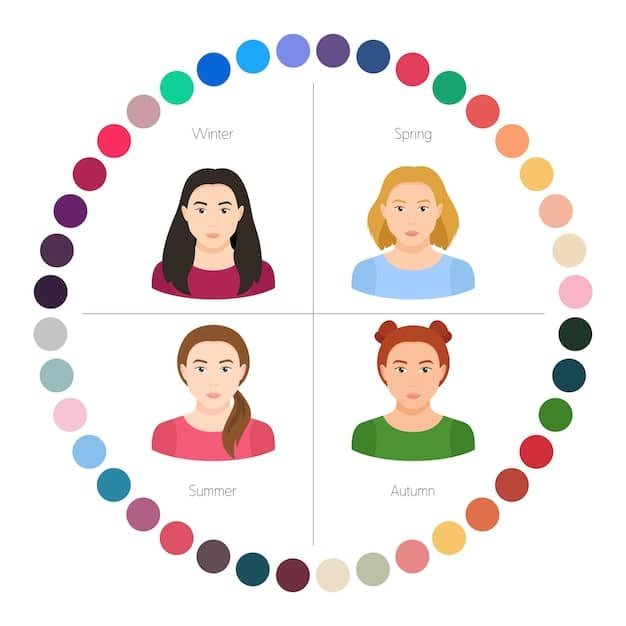How to Find Your Perfect Foundation Shade Online in 2025: US Guide

Choosing the right foundation shade online in 2025 in the US involves understanding your skin undertones, leveraging virtual try-on tools, and considering customer reviews to ensure a seamless match, ultimately achieving a natural and flawless complexion.
Finding your perfect foundation shade online can seem like a daunting task, especially with the ever-evolving technology in 2025. This guide will walk you through how to choose the right foundation shade online in 2025: a US buyer’s guide ensuring you achieve a flawless, natural look without the hassle of in-store shade matching.
Understanding Your Skin: The Key to Shade Matching
The first step in choosing the right foundation shade online is understanding your skin. This includes knowing your skin type, undertone, and surface tone. This knowledge will help you narrow down your options and make more informed decisions when browsing online.
Identifying Your Skin Type
Knowing your skin type (oily, dry, combination, or normal) is crucial because it affects how the foundation will look and feel on your skin. Different formulations are designed for different skin types, so selecting the right one will impact the overall finish.
- Oily Skin: Look for oil-free, matte formulations that won’t clog pores.
- Dry Skin: Opt for hydrating, dewy foundations that contain moisturizing ingredients.
- Combination Skin: Choose a balanced formula that controls oil in the T-zone while hydrating drier areas.
- Normal Skin: You have more flexibility, but a natural finish foundation often works best.
Determining Your Undertone
Your undertone is the subtle hue beneath the surface of your skin and is typically classified as warm, cool, or neutral. Determining your undertone is essential because it influences how the foundation shade appears on your skin.

Here are a few methods to help you determine your undertone:
- Vein Test: Look at the veins on your wrist. Blue or purple veins indicate a cool undertone, while green veins suggest a warm undertone. If you can’t tell, you likely have a neutral undertone.
- Jewelry Test: Consider which metal looks better against your skin. Gold complements warm undertones, while silver suits cool undertones.
- Neutral Colors: Think about which neutral colors make your skin look radiant. Warm undertones often look great in beige and olive, while cool undertones shine in gray and navy.
Once you understand the nuances of your skin type and undertone, you’re well-equipped to start your online foundation search. This foundational knowledge sets the stage for leveraging the technology and tools available in 2025.
Leveraging Online Tools and Technology
In 2025, brands offer a variety of online tools and technologies to help you find your perfect shade. These resources can significantly enhance your ability to match foundation shades remotely and accurately.
Virtual Try-On Tools
Many beauty brands now offer virtual try-on tools that use augmented reality (AR) to simulate how a foundation will look on your face. These tools use your device’s camera to overlay the foundation onto your image in real-time.
To effectively use virtual try-on tools:
- Ensure Good Lighting: Proper lighting is essential for accurate color representation.
- Clean Face: Make sure your face is clean and free of makeup for an accurate preview.
- Try Multiple Shades: Don’t settle for the first shade that looks close; experiment with a few to find the best match.
Shade-Matching Quizzes
Shade-matching quizzes ask a series of questions about your skin tone, undertone, and preferred coverage. Based on your answers, the quiz recommends several foundation shades from the brand’s range.
Tips for using shade-matching quizzes:
- Be Honest: Provide accurate information for the most reliable results.
- Cross-Reference: If possible, take multiple quizzes from different brands to see if there’s a consensus.
- Compare to Existing Products: If you already have a foundation that matches you well, compare its shade to the options suggested by the quiz.
Using Apps for Shade Comparison
In 2025, dedicated apps can analyze photos of your skin and suggest matching shades from various brands. These apps often use algorithms and machine learning to provide accurate matches.
Popular shade comparison apps include:
- MatchMyMakeup: Allows you to input your current foundation shade and recommends similar shades from other brands.
- Findation: Offers a comprehensive database of foundation shades and helps you find matches based on your existing products.
By utilizing these advanced online tools and technologies, you can significantly improve your chances of finding the right foundation shade without ever stepping into a store. These resources provide data-driven recommendations and realistic previews that can guide your purchasing decisions.
Understanding Foundation Formulas and Finishes
Once you know your skin type and undertone and have explored online tools, understanding foundation formulas and finishes is the next critical step. Different formulas cater to different skin types and desired looks, so it’s important to choose wisely.
Types of Foundation Formulas
Foundation formulas vary widely, from liquids and creams to powders and sticks. Each type offers different coverage levels and is suited for specific skin types.
- Liquid Foundation: Versatile and suitable for most skin types. Offers buildable coverage and comes in various finishes.
- Cream Foundation: Ideal for dry or mature skin due to its hydrating properties. Provides medium to full coverage.
- Powder Foundation: Great for oily skin as it helps control shine. Offers light to medium coverage and a matte finish.
- Stick Foundation: Convenient for on-the-go application and touch-ups. Offers medium to full coverage.
Choosing the Right Finish
The finish of a foundation refers to how it looks on your skin – matte, dewy, natural, or satin. The right finish can enhance your complexion and overall makeup look.

Consider the following when selecting a finish:
- Matte Finish: Best for oily skin as it controls shine and provides a non-reflective surface.
- Dewy Finish: Ideal for dry skin, offering a radiant and hydrated look. Can make oily skin appear too shiny.
- Natural Finish: A balanced option that mimics the look of healthy skin. Suitable for most skin types.
- Satin Finish: Offers a subtle glow without being overly shiny. Works well for combination skin.
Considering Coverage Levels
Foundations offer different levels of coverage, ranging from sheer to full. The coverage level you choose depends on your personal preference and the amount of imperfections you want to conceal.
- Sheer Coverage: Provides a light veil of color, evening out the skin tone without completely covering blemishes.
- Light Coverage: Minimally covers imperfections while still allowing natural skin to show through.
- Medium Coverage: Offers more concealment than light coverage, effectively covering redness and minor blemishes.
- Full Coverage: Completely covers imperfections, providing an even and flawless complexion.
Understanding the different foundation formulas, finishes, and coverage levels empowers you to make a more informed choice based on your skin’s specific needs and your desired makeup look. With this knowledge, you can better navigate online options and select a foundation that truly complements your complexion.
Reading and Interpreting Online Reviews
In the age of online shopping, customer reviews are invaluable. Learning to read and interpret reviews effectively can significantly aid your decision-making process, especially when choosing a foundation shade online.
Analyzing Shade Accuracy Feedback
Pay close attention to reviews that specifically mention the accuracy of the shade. Look for comments that compare the online shade representation to the actual product.
Key points to look for in reviews:
- Inconsistent Shades: Be cautious of reviews stating that the shade looks different in person than it does online.
- Undertone Accuracy: Check if reviewers found the undertone representation to be accurate compared to their skin.
- Photo Comparisons: Look for reviews with photos showing the foundation on different skin tones.
Considering Skin Type Mentions
Focus on reviews from people with similar skin types as yours. Their experiences will be more relevant and can provide insights into how the foundation performs on your skin.
For example:
- Oily Skin: Look for reviews that discuss how well the foundation controls oil throughout the day.
- Dry Skin: Check if reviewers with dry skin found the foundation to be hydrating and non-drying.
- Sensitive Skin: Look for mentions of whether the foundation caused any irritation or breakouts.
Filtering by Star Rating
While a high star rating is generally a good sign, it’s important to read both positive and negative reviews to get a balanced perspective. Filter reviews by star rating to see common issues and praises.
Tips for using star ratings:
- Read 3-Star Reviews: These often provide a balanced view of both pros and cons.
- Investigate Low Ratings: Understand the reasons behind negative reviews, but don’t let a few bad experiences deter you completely.
- Consider the Average: Look at the overall average rating as a general indicator of customer satisfaction.
Effectively reading and interpreting online reviews gives you valuable context and insights that go beyond product descriptions. By analyzing shade accuracy, skin type mentions, and star ratings, you can make a more informed decision and minimize the risk of choosing the wrong foundation shade online.
Ordering Samples and Utilizing Return Policies
Even with advanced online tools and insightful reviews, the best way to ensure a perfect foundation match is through trying the product directly. Ordering samples and understanding return policies are crucial strategies for online foundation shopping in 2025.
Requesting Samples When Available
Many beauty brands offer samples of their foundations, allowing you to test the shade and formula before committing to a full-size purchase. Take advantage of these opportunities whenever possible.
Tips for requesting and using samples:
- Check Brand Websites: Visit the brand’s official website to see if they offer samples.
- Join Loyalty Programs: Some loyalty programs offer exclusive samples as part of their benefits.
- Apply Correctly: Apply the sample to a small area of your face in natural light to assess the shade match and formula performance.
Understanding Return Policies
Before making a purchase, carefully review the retailer’s return policy. A generous return policy allows you to return the foundation if it doesn’t match your skin or meet your expectations.
Key considerations for return policies:
- Return Window: How long do you have to return the product?
- Condition of Return: Can you return the foundation if it’s been opened or used?
- Return Shipping: Who pays for the return shipping?
Using Online Communities for Swaps
If you end up with a foundation that doesn’t match, consider using online communities for swaps or exchanges. Many beauty forums and social media groups connect individuals looking to trade makeup products.
Platforms for makeup swaps:
- Reddit: Subreddits like r/MakeupExchange are popular for buying, selling, and swapping makeup.
- Facebook Groups: Many local and brand-specific Facebook groups facilitate makeup swaps.
- Dedicated Apps: Apps like Glambot offer a platform for buying and selling used makeup in good condition.
Ordering samples, understanding return policies, and participating in online communities offers additional layers of assurance and flexibility when shopping for foundation online. These strategies help you mitigate the risks associated with remote shade matching and ensure that you ultimately find the perfect foundation for your skin.
Adjusting for Seasonal Changes and Lighting
Your skin tone can change throughout the year due to sun exposure, so it’s important to adjust your foundation shade accordingly. Additionally, different lighting conditions can affect how your foundation looks, making it essential to check your shade in various environments.
Adapting to Seasonal Skin Tone Shifts
In the summer, your skin may become darker due to increased sun exposure, while in the winter, it may lighten. Adjust your foundation shade to match your current skin tone for a seamless look.
Strategies for seasonal shade adjustments:
- Summer Shade: Consider purchasing a slightly darker foundation for the summer months.
- Winter Shade: Switch to a lighter shade in the winter when your skin is less tanned.
- Mixing Shades: Blend two different foundations together to create a customized shade that matches your skin tone perfectly.
Testing in Different Lighting Conditions
The lighting in your home can differ significantly from natural daylight, affecting how your foundation looks. Always check your foundation in various lighting conditions to ensure it matches your skin.
Lighting scenarios to consider:
- Natural Daylight: The most accurate lighting for assessing shade match.
- Indoor Lighting: Check your foundation under both warm and cool indoor lights.
- Flash Photography: Take photos with flash to see if the foundation causes any flashback.
Understanding the Impact of Blue Light
In 2025, with increased screen time, it’s important to consider the impact of blue light on your skin. Blue light can affect your skin’s appearance and possibly influence how your foundation looks.
Tips for mitigating the impact of blue light:
- Blue Light Filters: Use blue light filters on your devices to reduce exposure.
- Antioxidant Skincare: Incorporate antioxidant-rich skincare products to protect your skin from blue light damage.
- Consider Foundation Formulation: Look for foundations that contain ingredients that provide protection against environmental stressors like blue light.
Adapting to seasonal changes, testing in different lighting conditions, and understanding the impact of blue light are important considerations for achieving a flawless foundation match year-round. By being mindful of these factors, you can ensure that your foundation always complements your complexion, regardless of the season or environment.
| Key Point | Brief Description |
|---|---|
| 🔍 Know Your Skin | Understand your skin type and undertone for a better match. |
| 📲 Use Online Tools | Utilize virtual try-on tools and shade-matching quizzes. |
| ⭐ Read Reviews | Check reviews for shade accuracy and skin type mentions. |
| ☀️ Adjust Seasonally | Adapt your shade for summer and winter skin tone changes. |
Frequently Asked Questions
▼
Check the color of your veins on your wrist. Blue or purple veins mean cool undertones, while green veins indicate warm. If you can’t tell, you likely have neutral undertones.
▼
Virtual try-on tools are generally helpful but not always perfect. Ensure good lighting and a clean face for the most accurate results. Always try multiple shades.
▼
Check the retailer’s return policy and return or exchange the foundation. Some online communities also offer makeup swaps if returns are not possible.
▼
Adjust your foundation shade at least twice a year – once in the summer when you may be more tanned and once in the winter when your skin is lighter.
▼
A matte finish foundation is generally best for oily skin, as it helps control shine and provides a non-reflective surface, keeping your skin looking fresh.
Conclusion
Choosing the right foundation shade online in 2025 requires a blend of understanding your skin, leveraging technology, and interpreting customer feedback. By following this guide, US buyers can confidently navigate the online beauty landscape and achieve a flawless, natural-looking complexion.





